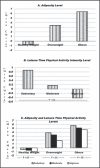Continuous metabolic syndrome risk score, body mass index percentile, and leisure time physical activity in American children
- PMID: 20695944
- PMCID: PMC8816477
- DOI: 10.1111/j.1751-7176.2010.00338.x
Continuous metabolic syndrome risk score, body mass index percentile, and leisure time physical activity in American children
Abstract
The objective of this study was to determine independent and joint association of body mass index (BMI) percentile and leisure time physical activity (LTPA) with continuous metabolic syndrome (cMetS) risk score in 12- to 17-year-old American children. The 2003 to 2004 US National Health and Nutrition Examination Survey data were used for this investigation. LTPA was determined by self-report. cMetS risk score was calculated using standardized residuals of arterial blood pressure, triglycerides, glucose, waist circumference, and high-density lipoprotein cholesterol. Multiple linear regression analysis was used to evaluate association of BMI percentile and LTPA with cMetS risk score, adjusting for confounders. Increased BMI percentile and LTPA were each associated with increased and decreased cMetS risk score, respectively ((P<.01). There was a gradient of increasing cMetS risk score by BMI percentile cutpoints, from healthy weight (-0.77) to overweight (3.43) and obesity (6.40) ((P<.05). A gradient of decreasing cMetS risk score from sedentary (0.88) to moderate (0.17) and vigorous (-0.42) LTPA levels was also observed (P<.01). The result of this study suggests that promoting LTPA at all levels of weight status may help to reverse the increasing trends of metabolic syndrome in US children.
(c) 2010 Wiley Periodicals, Inc.
Figures
Similar articles
-
Use of Continuous Metabolic Syndrome Score in Overweight and Obese Children.Indian J Pediatr. 2019 Oct;86(10):909-914. doi: 10.1007/s12098-019-02994-5. Epub 2019 Jul 13. Indian J Pediatr. 2019. PMID: 31300954
-
Physical Activity, Body Mass Index, and Clustered Metabolic Risk in U.S. Adolescents: 2007-2012 Nhanes.Metab Syndr Relat Disord. 2018 Mar;16(2):97-103. doi: 10.1089/met.2017.0072. Epub 2018 Jan 29. Metab Syndr Relat Disord. 2018. PMID: 29377771
-
Is the association of continuous metabolic syndrome risk score with body mass index independent of physical activity? The CASPIAN-III study.Nutr Res Pract. 2015 Aug;9(4):404-10. doi: 10.4162/nrp.2015.9.4.404. Epub 2015 Jul 27. Nutr Res Pract. 2015. PMID: 26244080 Free PMC article.
-
Screen time, sleep duration, leisure physical activity, obesity, and cardiometabolic risk in children and adolescents: a cross-lagged 2-year study.BMC Cardiovasc Disord. 2024 Oct 1;24(1):525. doi: 10.1186/s12872-024-04089-2. BMC Cardiovasc Disord. 2024. PMID: 39354336 Free PMC article.
-
Waist circumference and cardiometabolic risk: a consensus statement from Shaping America's Health: Association for Weight Management and Obesity Prevention; NAASO, The Obesity Society; the American Society for Nutrition; and the American Diabetes Association.Am J Clin Nutr. 2007 May;85(5):1197-202. doi: 10.1093/ajcn/85.5.1197. Am J Clin Nutr. 2007. PMID: 17490953 No abstract available.
Cited by
-
Cardiometabolic risk in US Army recruits and the effects of basic combat training.PLoS One. 2012;7(2):e31222. doi: 10.1371/journal.pone.0031222. Epub 2012 Feb 23. PLoS One. 2012. PMID: 22384004 Free PMC article.
-
Interventions to promote an integrated approach to public health problems: an application to childhood obesity.J Environ Public Health. 2012;2012:913236. doi: 10.1155/2012/913236. Epub 2012 Jun 26. J Environ Public Health. 2012. PMID: 22792120 Free PMC article.
-
Subclinical alterations in left ventricular structure and function according to obesity and metabolic health status.PLoS One. 2019 Sep 12;14(9):e0222118. doi: 10.1371/journal.pone.0222118. eCollection 2019. PLoS One. 2019. PMID: 31513625 Free PMC article.
-
Use of Continuous Metabolic Syndrome Score in Overweight and Obese Children.Indian J Pediatr. 2019 Oct;86(10):909-914. doi: 10.1007/s12098-019-02994-5. Epub 2019 Jul 13. Indian J Pediatr. 2019. PMID: 31300954
-
Exploring New Tools for Risk Classification among Adults with Several Degrees of Obesity.Int J Environ Res Public Health. 2023 Jun 30;20(13):6263. doi: 10.3390/ijerph20136263. Int J Environ Res Public Health. 2023. PMID: 37444110 Free PMC article.
References
-
- Reppert A, Steiner BF, Chapman‐Novakofski K. Prevalence of metabolic syndrome and associated risk factors in Illinois. Am J Health Promot. 2008;23:130–138. - PubMed
-
- Wang J, Ruotsalainen S, Moilanen L, et al; The metabolic syndrome predicts cardiovascular mortality: a 13‐year follow‐up study in elderly non‐diabetic Finns. Eur Heart J. 2007;28:857–864. - PubMed
-
- Kadota A, Hozawa A, Okamura T, et al; Relationship between metabolic risk factor clustering and cardiovascular mortality stratified by high blood glucose and obesity: NIPPON DATA90, 1990–2000. Diabetes Care. 2007;30:1533–1538. - PubMed
-
- Duncan GE, Li SM, Zhou XH. Prevalence and trends of a metabolic syndrome phenotype among U.S. adolescents, 1999–2000. Diabetes Care. 2004;27:2438–2443. - PubMed
-
- Cook S, Auinger P, Li C, et al; Metabolic syndrome rates in United States adolescents, from the National Health and Nutrition Examination Survey, 1999–2002. J Pediatr. 2008;152:165–170. - PubMed
MeSH terms
Grants and funding
LinkOut - more resources
Full Text Sources
Medical


